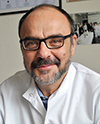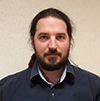Scientific Committee
Short Biographies
Athanase BENETOS, Geriatrician, Université de Lorraine, France
Coordinator of the Summer School
|
 |
Athanase Benetos graduated from the Medical School of the University of Athens in 1980 and obtained his PhD at the University of Paris VI in 1994. He is presently Professor of Geriatric Medicine and Biology of Aging, and Chairman of Geriatrics and Clinical Gerontology, at the University Hospital of Nancy-Lorraine. Senior Researcher at the National Institute of Biomedical Research (INSERM), he focuses his research on the age-related arterial changes, and their clinical manifestations and more especially on the role of telomeres dynamics on arterial aging, the contribution of the vascular aging on the physical and cognitive frailty and the management of hypertension in very old people. He has authored more than 360 papers published in peer-reviewed scientific journals (H index 72). In 2010 he published the book “ABCDaire du futur centenaire” (Robert Laffont, Paris). In 2019 he co-edited “The Cambridge Handbook of Successful Aging” (Cambridge University Press). |
|
Abraham AVIV, Physician, Telomeres Epidemiology, NJ, USA
|
 |
Abraham Aviv, MD is the Director of the Center of Human Development and Aging at New Jersey Medical School, Rutgers. Trained as a Pediatrician, with a specialty in Nephrology, Dr. Aviv’s original interests focused on hypertension and cardiovascular disease. He embarked on telomere research approximately 15 years ago, studying telomeres in newborns. Thereafter, Aviv has spearheaded multiple National Institutes of Health (NIH)-supported collaborations and consortia with scientists in the United States (U.S.) and abroad. These large-scale projects have researched telomere biology in the context of aging-related disease and population genetics. Aviv has lead research with the Framingham Heart Study, the Cardiovascular Health Study, the Family Heart Study, the Bogalusa Heart Study, the Health ABC Study, the Women’s Health Initiative, the Longitudinal Study of Aging Danish Twins (LSADT), Twins UK, the Jerusalem Lipid Research Clinic, the Norwegian Institute of Public Health. This research has generated a body of knowledge that defines the key characteristics and genetics of telomeres in contemporary humans. His laboratory is considered the premier facility for the measurement of telomere length (TL) by the high precision Southern blot method, the gold-standard of TL measurement methods. Aviv’s group, in collaborations with other investigators, has shown that telomere length at birth is the main determinant of telomere length in adult and that telomeres are longer in women than men and in African Americans and sub-Saharan Africans than in whites of European ancestry. The group has deciphered the relation between telomere length with insulin resistance, body mass index (BMI), cardiovascular disease (CVD) and longevity. The genetic consortium led by the group has contributed to understanding the potential role of telomere maintenance genes in the two major disease categories that largely define longevity of contemporary humans: cancer and cardiovascular disease. At present, Aviv’s research focuses on telomere dynamics in utero and evolutionary origin of human telomere length. |
|
Tim DE MEYER, Bioinformatics, Ghent, Belgium
|
 |
Tim De Meyer obtained an MSc (2004) and PhD (2008) in Bioscience Engineering from Ghent University, Belgium, where he presently is associate professor specialized in “omics” data-analysis and co-chair of the Master of Bioinformatics program. Currently he is developing statistical methods for population-scale allele-specific expression analyses, using cancer data as benchmark, yet aiming for application in an aging context. He is a core member of the longitudinal Asklepios Study on successful aging (over 2500 participating volunteers), for which he particularly focuses on the telomere biology and omics aspects. Featuring an H-index of 34, he has (co-)authored about 90 papers in peer-reviewed scientific journals, including 25 articles on telomere length biology published in journals such as Aging Cell, the Journal of the American College of Cardiology and the European Heart Journal. |
|
Simon TOUPANCE, Cell and Molecular Biology, Université de Lorraine, France
|
 |
Simon Toupance is a cell and molecular biologist. He is presently a research engineer at a research unit in Nancy, France, linked to Inserm (National Institute of Biomedical Research) and the University of Lorraine; DCAC (Acute and chronic Cardiovascular failure). He is also co-director of the University of Lorraine Center of Competence focused on telomere dynamics. He obtained a PharmD (2007) and a PhD (2011) from the University of Reims Champagne-Ardenne, France, where his work focused on telomere G-quadruplex ligands, tumor invasion and extracellular matrix. In 2013, he joined the DCAC lab and helped set up the high precision Southern blot telomere length (TL) measurement method. Since then he has participated in several clinical studies on the role of telomere dynamics in cardiovascular (CV) aging (TELARTA, ERA, STANISLAS, ADELAHYDE, FRAILSAFE). His current research work is focused on the role of endothelial progenitors in the CV disease-TL connection and the study of TL distribution with the introduction of the TL signature concept. |
|
Simon VERHULST, Evolutionary Ecology, Groningen Netherlands
|
 |
Simon Verhulst is an evolutionary ecologist, interested in life history evolution and mechanisms underlying trade-offs and ageing. I was trained at the University of Groningen, where I returned after PostDocs at the Universities of Bristol, Oxford and Uppsala. He combines epidemiological work on human telomeres with a mixture of correlational and experimental studies on free-living and captive animals (birds mostly) in which they study telomeres and physiological traits to investigate how they are affected by life history traits such as current reproduction and future survival and reproduction. They have expertise in the measurement of avian telomeres, using an ‘in gel’ TRF technique that omits interstitial telomeric sequences from the gel picture, and frequently host researchers to measure telomeres in their lab.
Publications - A recent video on one of our core projects: Video |
|


